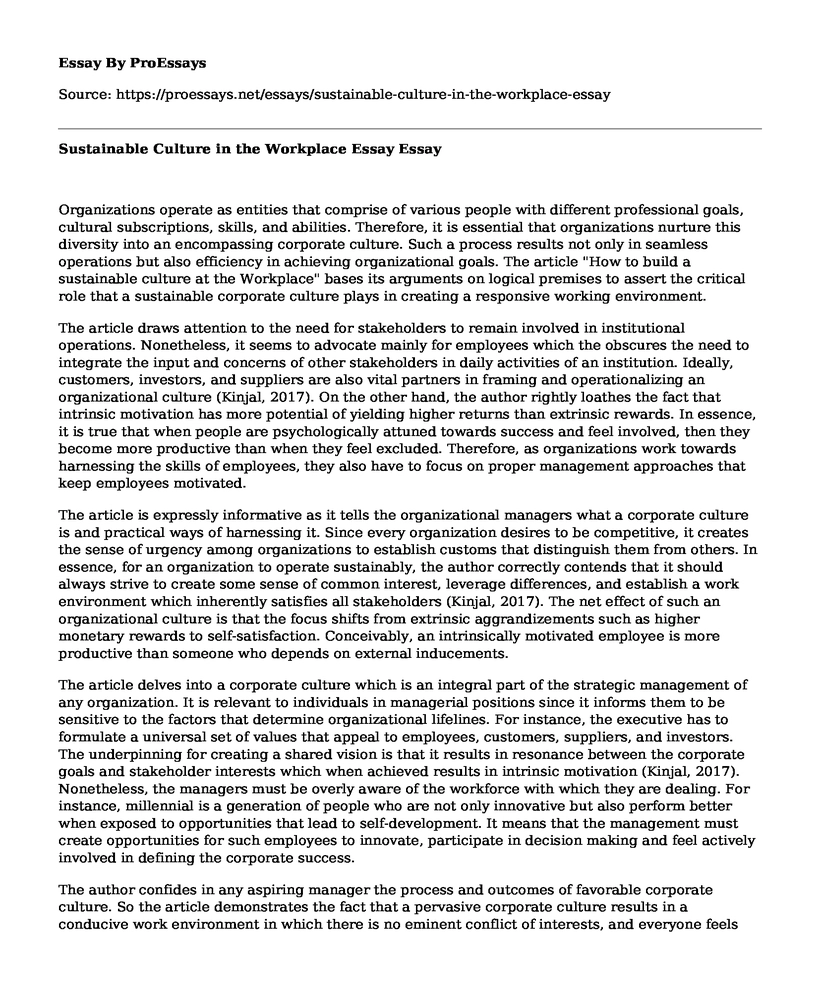Organizations operate as entities that comprise of various people with different professional goals, cultural subscriptions, skills, and abilities. Therefore, it is essential that organizations nurture this diversity into an encompassing corporate culture. Such a process results not only in seamless operations but also efficiency in achieving organizational goals. The article "How to build a sustainable culture at the Workplace" bases its arguments on logical premises to assert the critical role that a sustainable corporate culture plays in creating a responsive working environment.
The article draws attention to the need for stakeholders to remain involved in institutional operations. Nonetheless, it seems to advocate mainly for employees which the obscures the need to integrate the input and concerns of other stakeholders in daily activities of an institution. Ideally, customers, investors, and suppliers are also vital partners in framing and operationalizing an organizational culture (Kinjal, 2017). On the other hand, the author rightly loathes the fact that intrinsic motivation has more potential of yielding higher returns than extrinsic rewards. In essence, it is true that when people are psychologically attuned towards success and feel involved, then they become more productive than when they feel excluded. Therefore, as organizations work towards harnessing the skills of employees, they also have to focus on proper management approaches that keep employees motivated.
The article is expressly informative as it tells the organizational managers what a corporate culture is and practical ways of harnessing it. Since every organization desires to be competitive, it creates the sense of urgency among organizations to establish customs that distinguish them from others. In essence, for an organization to operate sustainably, the author correctly contends that it should always strive to create some sense of common interest, leverage differences, and establish a work environment which inherently satisfies all stakeholders (Kinjal, 2017). The net effect of such an organizational culture is that the focus shifts from extrinsic aggrandizements such as higher monetary rewards to self-satisfaction. Conceivably, an intrinsically motivated employee is more productive than someone who depends on external inducements.
The article delves into a corporate culture which is an integral part of the strategic management of any organization. It is relevant to individuals in managerial positions since it informs them to be sensitive to the factors that determine organizational lifelines. For instance, the executive has to formulate a universal set of values that appeal to employees, customers, suppliers, and investors. The underpinning for creating a shared vision is that it results in resonance between the corporate goals and stakeholder interests which when achieved results in intrinsic motivation (Kinjal, 2017). Nonetheless, the managers must be overly aware of the workforce with which they are dealing. For instance, millennial is a generation of people who are not only innovative but also perform better when exposed to opportunities that lead to self-development. It means that the management must create opportunities for such employees to innovate, participate in decision making and feel actively involved in defining the corporate success.
The author confides in any aspiring manager the process and outcomes of favorable corporate culture. So the article demonstrates the fact that a pervasive corporate culture results in a conducive work environment in which there is no eminent conflict of interests, and everyone feels part of the team. There are specific steps towards achieving such a state organizational culture (Kinjal, 2017). The article shows that the measures fall squarely within the realms of strategic human resources management. Therefore, the executive management of an organization must ensure that the interventions work in such a way that creates complementarity.
An organization should align the company goals to the personal values of employees through competitive recruitment. Also, the organization must create clear frameworks of communication through which to listen to concerns of all stakeholders within the continuum of its operations and conduct regular performance evaluation which keeps the workers aligned to their specific roles. Since customers or clients are the final targets of any organizations, the workers must be nurtured through adequate training to ensure due diligence in dealing with customers within the concept of a customer-centric approach to operations. An unambiguous code of ethics should also be drafted to regulate the relationships among workers themselves and with the top echelons of management.
Reference
Kinjal C. (22, Sep 2017). How to build a sustainable culture in the workplace. Financial Express. Available on http://www.financialexpress.com/jobs/how-to-build-a-sustainable-culture-at-the-workplace/866351/
Cite this page
Sustainable Culture in the Workplace Essay. (2022, Mar 29). Retrieved from https://proessays.net/essays/sustainable-culture-in-the-workplace-essay
If you are the original author of this essay and no longer wish to have it published on the ProEssays website, please click below to request its removal:
- Social Responsibility: Federal Minimum Wage Essay
- Organizational Behavior Questions and Answers
- Marla's Work Profile - Essay Sample
- Elements of a Well-Written Mission and Project Manager Profession Essay Examples
- Spokesperson Career Paper Example
- Essay Sample on Iceland: A Model of Sustainable Energy Progress
- Strategies and Steps in Database Security - Paper Example







